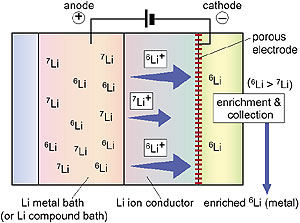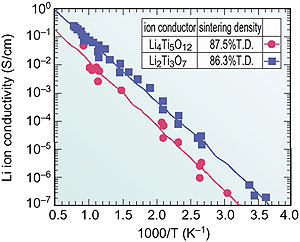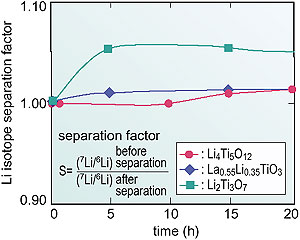The high concentration of 6Li in a fusion reactor blanket system is needed to effectively produce tritium, which is the fuel of fusion reactors. Until now, the mercury amalgamation process is used for Li isotope separation. However, to avoid environmental mercury pollution, it is desired that a new Li isotope separation technology is developed. Then, the isotope separation technology was worked out and demonstrated using Li ion conductors, in which the moving velocities of the isotope ions are different owing to the mass difference (Fig. 3-20).
Three types of Li ionic conductors, which were a spinel Li4Ti5O12, a perovskite La0.55Li0.35TiO3 and ramsdellite Li2Ti3O7 from the Li2O-TiO2 system, were selected as the Li ion conductors. Electric conductivities of these three ion conductors were in the range from 10-7 to 10-1S/cm (room temperature to 800 degrees cent.). It was shown from the results that each ionic conductor has sufficient electric conductivity for isotope separation. The Li isotope separation factors of the three Li ionic conductors were 1.014 for the spinel, 1.010 for the perovskite and 1.058 for the ramsdellite. These are by no means inferior to those of the separation factors (1.02 to 1.07) obtained by the mercury amalgamation process. We are planning to develop practically, the Li isotope separation technology with ion conductors. |



